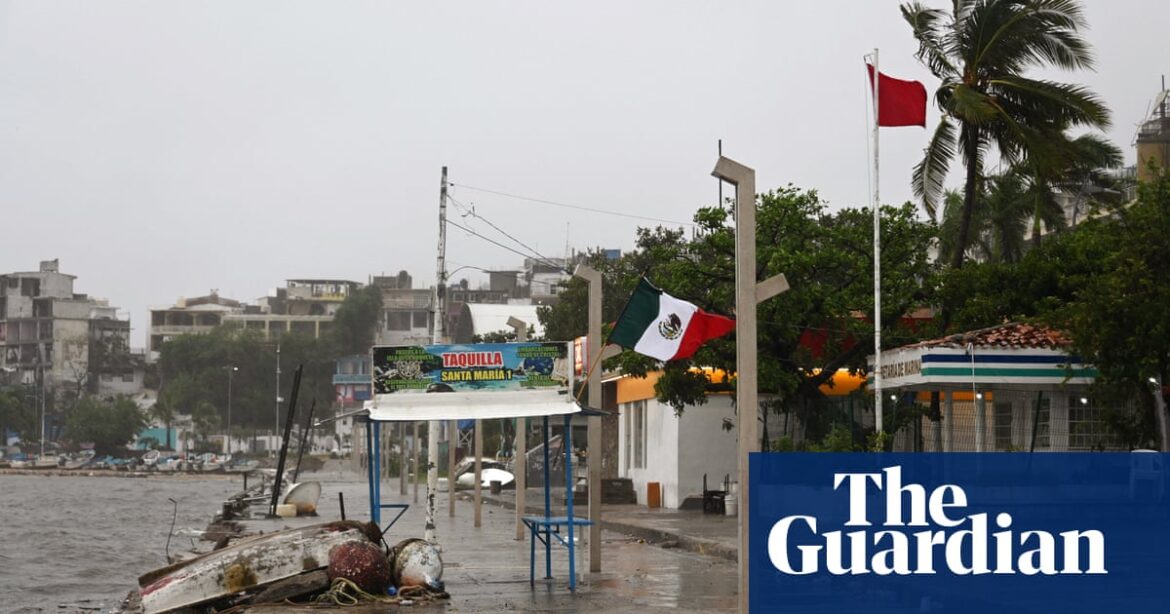
Two people have died after former hurricane John barreled into Mexico’s southern Pacific coast, blowing tin roofs off houses, triggering mudslides and toppling scores of trees.
It came ashore near the town of Punta Maldonado late on Monday as a category 3 hurricane with maximum sustained winds of 120mph (190km/h). It weakened back to tropical storm status early on Tuesday with maximum sustained wind speeds of 50mph (85km/h) and was expected to weaken rapidly.
Evelyn Salgado, the governor of the coastal state of Guerrero, said on Tuesday that two people had died when the storm sent a mudslide crashing into their house on the remote mountain of Tlacoachistlahuaca, further from the coast.
The United States National Hurricane Center warned that the storm’s slow pace and heavy rains could cause potentially catastrophic flash flooding and mudslides in some Mexican states.
“Seek higher ground, protect yourselves and do not forget that life is the most important thing; material things can be replaced. We are here,” the Mexican president, Andrés Manuel López Obrador, wrote on the social media platform X.
The storm was expected to batter Punta Maldonado and the nearby tourist hubs Acapulco and Puerto Escondido before being weakened over the high terrain inland.
The center said heavy rainfall over coastal south-west Mexico through the week was likely to cause “significant and possible catastrophic, life-threatening flash flooding and mudslides” in parts of Chiapas, Oaxaca and Guerrero states.
On Tuesday morning, the storm was 60 miles (100km) north-northwest of Acapulco and moving northwest at 8mph (13km/h). It was forecast to dawdle along the coastal mountains, even dip back over the Pacific, but continue weakening throughout the day.
Monday’s unexpected surge in strength caught scientists, authorities and residents of the area by surprise, something the AccuWeather senior meteorologist Matt Benz attributed to warmer oceans, which add fuel to hurricanes.
As a result, surprise surges in hurricanes’ strength have become increasingly common, Benz said.
“These are storms that we haven’t really experienced before,” he said. “Rapid intensification has occurred more frequently in modern times as opposed to back in the historical record. So that’s telling us there’s something going on there.”
Residents were tense in Oaxaca’s coastal cities as the forecast shifted and authorities responded.
Laura Velázquez, the federal coordinator of civil protection, told residents of Pacific coastal cities they should evacuate their homes and head to shelters in order to “protect theirs and their family’s lives”.
“It’s very important that all citizens in the coastal zone … take preventive measures,” Velázquez said.
Oaxaca’s governor said the state government evacuated 3,000 people and set up 80 shelters. It also said it sent out 1,000 military and state personnel to address the emergency.
In Puerto Escondido flip-flop-clad tourists walked through heavy rain and fishers pulled their boats out of the water. Strong rains in previous days have already left some roads in the region in a precarious position.
The storm is bleak news for the region, which was walloped by Otis, a similar rapidly intensifying hurricane, in 2023.
Otis devastated the resort city of Acapulco, where residents had little warning of the strength of what was about to hit them. One of the most rapidly intensifying hurricanes ever seen, scientists at the time said it was a product of changing climate conditions.
Otis blew out power in the city for days, left bodies scattered on the coast and desperate family members searching for lost loved ones. Much of the city was left in a state of lawlessness and thousands scavenged in stores, scrambled for food and water.
López Obrador’s government received harsh criticism for its slow response to Otis, but authorities have since pledged to pick up their speed.
The president-elect, Claudia Sheinbaum, said her government planned to work on improving an early alert system, similar to the one the country has for earthquakes.
Source: theguardian.com



